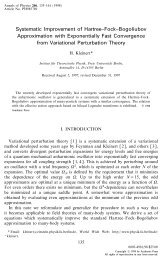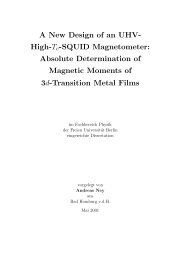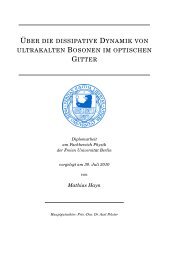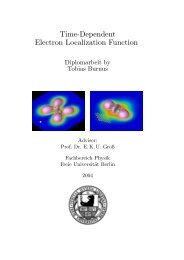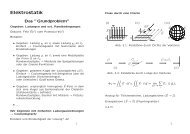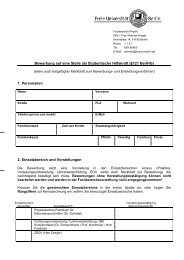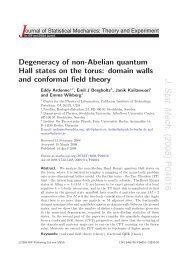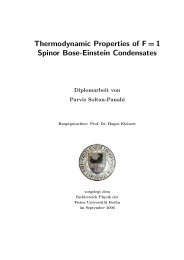Diploma thesis - Fachbereich Physik
Diploma thesis - Fachbereich Physik
Diploma thesis - Fachbereich Physik
You also want an ePaper? Increase the reach of your titles
YUMPU automatically turns print PDFs into web optimized ePapers that Google loves.
3.2. GROUND-STATE ENERGY WITHOUT EXTERNAL CURRENT 41<br />
For the general case k ≥ 3, it is helpful to rewrite (3.10) in the form<br />
∞∑<br />
φ k (x) = c (k)<br />
m xm , with c (k)<br />
m ≡ 0 for m > k + 2 , (3.14)<br />
m=1<br />
as this allows the application of the Cauchy product rule to the product of the derivatives<br />
φ ′ k−l (x) and φ′ l (x) in (3.9). The recursively determinable solution for the φ k(x) and the<br />
energy corrections ǫ k is then obtained as<br />
c (k)<br />
m<br />
ǫ k<br />
=<br />
(m + 2)(m + 1)¯h<br />
2mMω<br />
= −¯h2<br />
M c(k) 2 − ¯h2<br />
2M<br />
c (k) ¯h<br />
m+2 +<br />
2mMω<br />
∑k−1<br />
l=1<br />
∑ ∑<br />
k−1 m+1<br />
l=1<br />
n=1<br />
with c (k)<br />
m<br />
n(m + 2 − n) c (l)<br />
n c (k−l)<br />
m+2−n ,<br />
≡ 0 for m > k + 2 , (3.15)<br />
c (l)<br />
1 c(k−l) 1 . (3.16)<br />
Applying this result leads to the expansion coefficients and the energy correction in the third<br />
order of the coupling constant:<br />
c (3)<br />
1 = − 5A3¯h<br />
M 4 ω 7 + 6AB¯h<br />
M 3 ω 5 ,<br />
And for the fourth order one obtains<br />
c(3) 2 = 0 , c (3)<br />
3 = − 13A3<br />
12M 3 ω 6 + 3AB<br />
2M 2 ω 4 ,<br />
c (3)<br />
4 = 0 , c (3)<br />
5 = − A3<br />
10M 2¯hω 5 +<br />
c (4)<br />
1 = 0 , c (4)<br />
2 = 305A4¯h<br />
32M 5 ω − 123A2 B¯h<br />
+ 21B2¯h<br />
9 8M 4 ω 7 8M 3 ω , 5<br />
c (4)<br />
4 = 99A4<br />
64M 4 ω 8 − 47A2 B<br />
16Mω 6 + 11B2<br />
16M 2 ω 4 ,<br />
c (4)<br />
6 =<br />
5A 4<br />
48M 3¯hω 7 −<br />
AB<br />
5M¯hω 3 , (3.17)<br />
and ǫ 3 = 0 . (3.18)<br />
c(4) 3 = 0 ,<br />
c(4) 5 = 0 ,<br />
A2 B<br />
4M 2¯hω 5 + B 2<br />
12M¯hω 3 , (3.19)<br />
and ǫ 4 = − 465A4¯h 3<br />
32M 6 ω 9 + 171A2 B¯h 3<br />
8M 5 ω 7 − 21B2¯h 3<br />
8M 4 ω 5 . (3.20)<br />
Comparing (3.13), (3.18), and (3.20) with (2.188), one sees that the result obtained by<br />
Bender-Wu recursion is indeed identical to the one obtained by explicitly evaluating Feynman<br />
diagrams. Since one wants to drive the expansion to higher orders, it is important to optimize<br />
the recursion formula with regard to its evaluation by a computer. To this end, it is helpful to<br />
introduce natural units, in which one has ¯h = 1, M = 1. Furthermore, since calculations on a<br />
computer can be performed more effectively when dealing with mere rational numbers, which<br />
are not afflicted with parameters like A, B, or ω, it is desirable to expand the coefficients<br />
and the energy corrections ǫ k in products of powers of these parameters. Dimensional<br />
considerations lead to the following approaches for the coefficients c (k)<br />
c (k)<br />
m<br />
m :<br />
⌊k/2⌋<br />
c (k)<br />
m = ∑ A k−2λ B λ<br />
c(k)<br />
ω5k/2−m/2−2λ m,λ ,<br />
λ=0<br />
with c(k)<br />
m,λ<br />
≡ 0 for m > k + 2 , (3.21)




